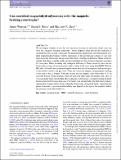Can non-ideal magnetohydrodynamics solve the magnetic braking catastrophe?
Date
21/03/2016Metadata
Show full item recordAbstract
We investigate whether or not the low ionization fractions in molecular cloud cores can solve the ‘magnetic braking catastrophe’, where magnetic fields prevent the formation of circumstellar discs around young stars. We perform three-dimensional smoothed particle non-ideal magnetohydrodynamics (MHD) simulations of the gravitational collapse of one solar mass molecular cloud cores, incorporating the effects of ambipolar diffusion, Ohmic resistivity and the Hall effect alongside a self-consistent calculation of the ionization chemistry assuming 0.1 μm grains. When including only ambipolar diffusion or Ohmic resistivity, discs do not form in the presence of strong magnetic fields, similar to the cases using ideal MHD. With the Hall effect included, disc formation depends on the direction of the magnetic field with respect to the rotation vector of the gas cloud. When the vectors are aligned, strong magnetic braking occurs and no disc is formed. When the vectors are anti-aligned, a disc with radius of 13 au can form even in strong magnetic when all three non-ideal terms are present, and a disc of 38 au can form when only the Hall effect is present; in both cases, a counter-rotating envelope forms around the first hydrostatic core. For weaker, anti-aligned fields, the Hall effect produces massive discs comparable to those produced in the absence of magnetic fields, suggesting that planet formation via gravitational instability may depend on the sign of the magnetic field in the precursor molecular cloud core.
Citation
Wurster , J , Price , D J & Bate , M R 2016 , ' Can non-ideal magnetohydrodynamics solve the magnetic braking catastrophe? ' , Monthly Notices of the Royal Astronomical Society , vol. 457 , no. 1 , pp. 1037-1061 . https://doi.org/10.1093/mnras/stw013
Publication
Monthly Notices of the Royal Astronomical Society
Status
Peer reviewed
ISSN
0035-8711Type
Journal article
Collections
Items in the St Andrews Research Repository are protected by copyright, with all rights reserved, unless otherwise indicated.

